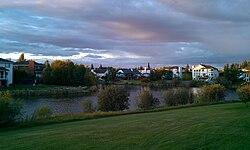 Distribution of Alberta's 260 urban municipalities |
Alberta has provincial legislation allowing its municipalities to conduct municipal censuses. [1] Municipalities choose to conduct their own censuses for multiple reasons such as to better inform municipal service planning and provision, inform an electoral boundary review, or to simply update their populations since the last federal census. [2] [3]
Contents
- Municipal census results
- Breakdowns
- Urban and rural service areas
- Hamlets
- Shadow population
- See also
- Notes
- References
- External links
Alberta began the year of 2024 with 342 municipalities. [4] Of these, 24 notified Alberta Municipal Affairs of their intentions to conduct a municipal census in 2024. [5] Censues were ultimately conducted by five cities, ten towns, two village, two specialized municipalities, three municipal districts, and one improvement district.
